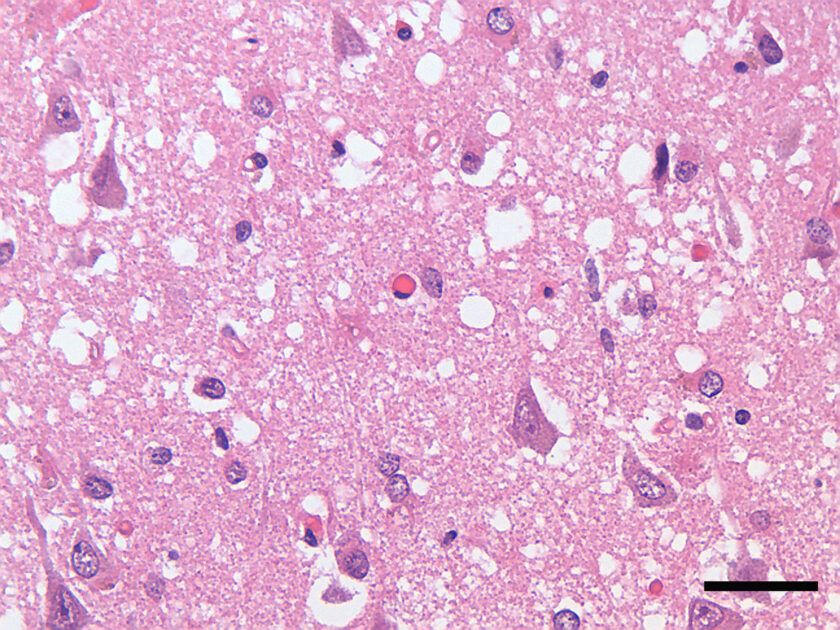






























































Image Source: Tulemo – CC BY-SA 4.0
The deaths of two people and illness of one from a possible fatal and rare brain disease clustering in Oregon have public health officials and medical professionals worried.
They fear a returning threat from the prion disease mad cow (bovine spongiform encephalopathy) which roiled US markets 20 years ago.
It led to devastating international boycotts of US beef, agricultural market upheavals, medical panic and widespread distrust of the US government which was seen to mismanage the outbreak.
What Are Prions?
Prions are invisible infectious particles of protein that lack a nucleus. Though not technically “alive,” they can reproduce and cannot be “killed” by heat, autoclaves, ammonia, bleach, hydrogen peroxide, alcohol, phenol, lye, formaldehyde or radiation. In fact they are said to remain in soil for years.
Prion diseases are also found in sheep–– scrapie––and in deer–– chronic wasting disease––the latter causing continued hunting precautions, hunter fears and even carcass dumping over the years.
The most common human prion brain disease is the fatal and incurable Creutzfeldt-Jakob disease (CJD), called variant CJD when caused by meat. Symptoms of CJD and its variant include, memory loss, personality changes, difficulty sleeping and speaking, muscle jerks, loss of balance and vision problems.
During the mad cow scares, the National Animal Disease Laboratory in Ames, Iowa was charged with studying prion disease but it was accused of erroneously believing that heat or chlorine could kill the infectious particles and ejecting potentially infectious animal waste in the local sewer system.
Panic Over A New Disease
In 2003, the USDA announced a Holstein cow, imported from Canada and slaughtered in Washington state, that tested positive for mad cow disease.
What happened to the meat people asked.
The US government said the FDA “located all potentially- infectious product” and the “product was disposed of in a landfill in accordance with Federal, State and local regulations.” But the Los Angeles Times reported that despite “a voluntary recall… some meat, which could have contained the Washington cow, was sold to restaurants in several Northern California counties.” Who should people have believed?
Furthering the fears, Alameda County health officer Dr. Anthony Iton said he had been informed of the mad cow but no restaurant owners had been told….and that federal inspectors didn’t even visit the properties until 10 days after the recall.
There were more scares. Eleven head of cattle thought to have eaten the same feed as the index cow were never found nor did authorities ever find the “source of the feed thought to have sickened the Holstein” said the Associated Press.
Similarities to Other Health Epidemics
Within 24 hours of the USDA mad cow announcement, Mexico, Russia, Brazil, South Africa, Hong Kong, Japan, Singapore, Taiwan, Malaysia, South Korea, and 90 other countries banned the import of US beef producing huge agricultural fallouts.
And there were other epidemic parallels:
+ In its widespread economic shutdowns mad cow foreshadowed Covid 19 .
+ In its early transmission vagaries, many remembered early AIDS: How was the disease spread? How fatal was it? Who was at risk? How could someone stay safe?
+ Embalmers balked at handling bodies of both those who succumbed to mad cow and AIDS.
+Mad cow was also zoonotic––jumping from cows to humans––like diseases that preceded and followed it. Both Covid-19 and SARS were hosted in bats, civet cats, raccoon dogs and wet markets before surfacing in humans.
+ The currently mutating avian flu provides more zoonotic fears. So far, it has spread to dairy cattle, pigs, wild mammals like foxes, seals and raccoons, zoo animals, household pets and humans.
Some ask if the “litter” from the hundreds of millions of recently depopulated birds––their bedding, manure and feathers––helped to spread the disease since it’s used as a feed supplement. Yes, you read that correctly.
Will We Dodge A Prion Bullet?
CJD and vCJD cannot be diagnosed until autopsy so the cause of the Oregon deaths or causes are not clear yet nor sources identified. Moreover, drugmakers have collaborated with meat producers to create GMO cows who can’t get mad cow so maybe everything will be okay. Already a “GalSafe” pig, sans alpha-gal sugar, pigs with more omega-3 fatty acids and animals with human genes such as dairy cows have been created in the lab.
Still, food producers and medical institutions––a major CJD transmission risk is surgery–– are watching the Oregon situation with trepidation. No one wants a repetition of mad cow––or other animal epidemics!
The post Is a Prion Epidemic Brewing? appeared first on CounterPunch.org.
This post was originally published on CounterPunch.org.